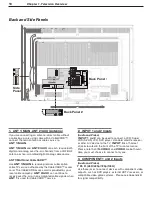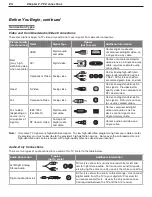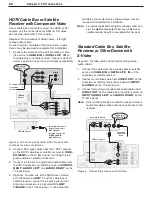
Chapter 1. Television Overview
13
Guidelines for Setting Up and Using
Your New Widescreen TV
Getting Started
1.
Read the section entitled
“Important Information
About Your TV”
starting on page 5.
2.
Choose a location for your TV.
• Allow at least four inches of space on all sides of
the TV help prevent overheating.
• Avoid locations where light may reflect off the
screen.
• See the stand requirements under
“Important
Information About Your TV.”
3.
Install the batteries in the remote control. See
chapter 3, “TV Operation
,” for information on use
and care of the remote control.
4.
Plug your TV into a power outlet. The
POWER
indicator
on the front of the TV will start blinking rapidly. After
the
POWER
indicator stops blinking, press the
POWER
key
to power on the TV.
5.
When the Welcome screen appears the first time you
power on the TV, select a language for TV menus.
You can later change the language through the
Setup
menu.
6.
Some TVs are shipped from the factory with demo
mode active for use in retail stores. If demo mode is
active when you first turn on the TV:
a. Press
MENU
.
b. When the Main menu appears with
Setup
high-
lighted, press
ENTER.
c. When the Setup menu opens, press to highlight
the on-screen
Demo Mode
Off
button.
d. Press
ENTER
.
7
. Connect your other A/V devices to the TV and assign
device names to the TV inputs when prompted. See
chapter 2, “TV Connections,”
for connection dia-
grams. You can reassign device names later if needed.
See
“Input Name Menu”
in
chapter 4, “TV Menu
Settings.”
8.
Memorize channels
if you plan to watch over-the-air
channels or programming over direct cable. Channel
memorization may take up to 15 minutes to complete.
See
“Setup Menu”
in
chapter 4, “TV Menu Settings
.
”
9
. You can now start watching TV or you can perform
additional setup and customization through the TV
menus.
Additional TV Setup
1
. To program the remote control to operate your other
A/V devices, see
chapter 5, “Operating Other
Devices with the Remote Control
.”
2.
Review
chapter 4, “TV Menu Settings,”
to custom-
ize TV operation. Press the
MENU
key to enter the menu
system. Some examples of settings you may wish to
change include:
•
Energy Mode.
For faster power-on, keep the
Energy Mode set to
Fast Power On
. For lower
power consumption while the TV is off, use the
Low Power
setting. See
“Setup Menu.”
•
Input Name.
Change the device names that
appear in the Input Selection menu. See
“Input
Name Menu.”
•
Icon Order.
Rearrange the device icons in the
Input Selection menu to put frequently used icons
near the front. See
“Icon Order Menu.”
•
FAV.
Create lists of your favorite channels so you
can find them quickly. See
“Channel Menu.”
•
Clock.
If you wish to schedule future recordings
or use the Timer feature to have the TV come on
automatically, you must first set the TV clock to
the correct time. See
“Setup Menu.”
•
Parental Lock.
You can restrict TV viewing by
program rating or by time of day. You can also
disable the front-panel buttons—useful if you have
small children. See
“Parental Lock Menu.”
•
Video Settings.
Change the video adjustments
to get the best picture for your viewing conditions.
See
“Audio/Video Menu.”
Digital Cable Ready (CableCARD™)
Your widescreen Mitsubishi HDTV is “Plug-and-Play” digital cable ready. It can descramble a cable provider’s one-way
digital signals with the use of a CableCARD security module. The CableCARD is used in place of a traditional cable box
to access digital cable programming (including high definition). Contact your local cable provider for availability infor-
mation and service details.
Содержание LT-37131
Страница 34: ...34 Chapter 2 TV Connections ...
Страница 41: ...Chapter 3 TV Operation 41 TV Picture Formats See descriptions on the preceding page ...
Страница 62: ...62 Chapter 4 TV Menu Settings ...
Страница 74: ......
Страница 90: ......
Страница 92: ...92 Appendices This page intentionally left blank ...
Страница 107: ......














































